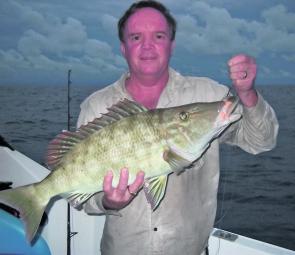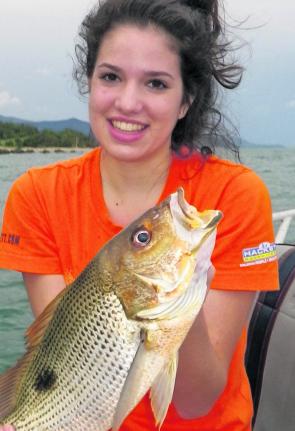With the first ever two week Easter school holiday break in the first half of April, family anglers will be hoping for a good spell of weather.
The tides are certainly ideal for fishing around the April full moon, and hopefully the weather will cooperate in the first ten days of the school holidays. Unfortunately the odds are stacked against us, with only one pristine Easter in the last ten in the Cairns area.
The wannabe wet season didn’t materialize in January and February, which usually points to a late finish. The upside is the water temperature is usually still high, so the summer trophy fish like jacks, barra and fingermark are still very active.
Fingermark have been the main players this wet, with a good sprinkling of jacks and barra coming from the rivers and headlands. The afternoon rising tide in the middle of the school holidays will be ideal to chase this tropical trio.
Focus your efforts on the rising tide up until dark with lures and live baits around rocks and snags. The water temperature will dictate the best approach. If it is still summer-hot work the shallow areas like run-off drains and rock bars that break the surface. As the water cools, start to go deeper and use your sounder to locate fish on deep structure. Anchor so you can get a bait or lure right onto the structure.
Another good approach for chasing the tropical trio in deeper water is to super-slow troll deep diving lures that get down and bang the bottom. If you are not bumping the bottom on a number of occasions each run, your lure is not deep enough.
Ideally, you want to be bumping the top of any structure. When the lure bumps, let it off and let it float up, then work it forward with a jerky motion. This often triggers predators to strike.
Braid is ideal for this technique as you have a lot more feel of what the lure is doing at any given moment. Mono tends to dampen the signal and slow down the relay of information to the rod tip.
In the first week of the school holidays the early morning rising tide looks good for chasing grunter on the rubble, weed and shell grit grounds in the estuaries and out on the flats. Chasing the likes of grunter is a more family friendly fishing approach, as there is more action to keep the kiddies amused.
Live baiting and luring is best kept for the adults or hardened junior fishos who are prepared to wait it out for the chance to nail a trophy. Chasing your own bait with a yabby pump or cast net prior to fishing is often a highlight for young kids, so allow enough time to gather bait prior to fishing without worrying that you are missing the tide. Kids love to play with yabbies and live bait in a bucket, so carry a second play bucket to keep the kids amused without stressing out your main bait supply.
The rising tide is best, with grunter tending to go off the bite once the tide turns. With the tides building to three metres plus in the lead up to the full moon, grunter should be on the move. Use yabbies, fresh strip baits or fresh peeled prawns. Bigger grunter will also take small live baits, with prawns, mullet and sardines ideal.
Any live bait over 10cm is best kept for strip bait, with seven to eight centremetre livies perfect for big grunter. If you are fishing where you can use two lines per angler, having one dead bait and one live bait out is a good strategy.
Remember, if you are fishing in a Yellow Zone you are only permitted one hand held rod or line per angler. While there are no Yellow Zones close to Cairns, there are a number within day trip distance.
Expect a few interlopers when chasing grunter, with the majority unfortunately being of the vermin variety. There will still be the odd giant trevally, golden trevally and queenfish around to spice things up a bit. Throw in the occasional bream, flathead, cod and salmon and it can make for an interesting morning’s fishing.
Good Friday is a bit of a phenomenon, with two high tides over three metres on the one day. If you really want to OD on grunter fishing, you can fish the morning rise and then late into the night.
The April full moon also marks the switch from the morning high tide being the biggest each day to the evening tide being the biggest. It will remain that way until the September full moon, when it will swap back to the biggest high tide being in the morning.
This switch in high tides also marks the change over period from summer to winter species. Every year is slightly different, but April usually brings a decline in summer species activity and an increase in winter species. Water temperature is also a significant factor in the switch over. If the water temperature remains high, the summer species will continue to feed actively while the winter fish will be slower to appear.
Big tides are also good for getting muddies on the move, so don’t forget the pots when taking the kids fishing over the school holidays. There were some good crabs around during the wet and the beginning of the cooler months usually see an increase in mud crab numbers.
Prawns are often running around Easter, though the lack of an early wet may slow things this year. The beaches are usually the best bet, so keep your ear to the ground and eyes out for any tell-tale flicks across the surface.
The freshwater scene is usually lit up in April, as streams begin to clear and the water temperature is still relatively high. Wait until after a fresh, when the water is starting to go milky and focus your efforts at the top of holes and at any colour change caused by smaller streams running into the main flow.
As the water temperature cools, mackerel will start to become more prominent. Early in the season they tend to hang deeper looking for the cooler water, so start your search at the bottom and work up rather than the more common starting at the surface and working down. School or doggie mackerel, in particular, will be down deep and will often show on the sounder just off the bottom around inshore wrecks and reefs.
In the calm periods the reef is certainly worth a look, with large mouth nannygai, small mouth nannygai, red emperor, spangled emperor, coral trout, cobia and trevally on the chew. Less common catches, like reef red bream and long-nosed emperor will help add a bit of interest to the esky.
The temperatures are usually starting to become more bearable, making a day trip to the reef a bit more pleasurable. There is nothing quite like heading east just on daylight, with a cool southwesterly blowing out of Cairns Inlet and a flat sea in front of you.
Reads: 2431
Long nosed emperor will be welcomed by your esky, especially ones like this beauty caught by John Wedrat.

Fingermark, like the one caught by Ally Lavalle-Smith, have been the main players this wet.




